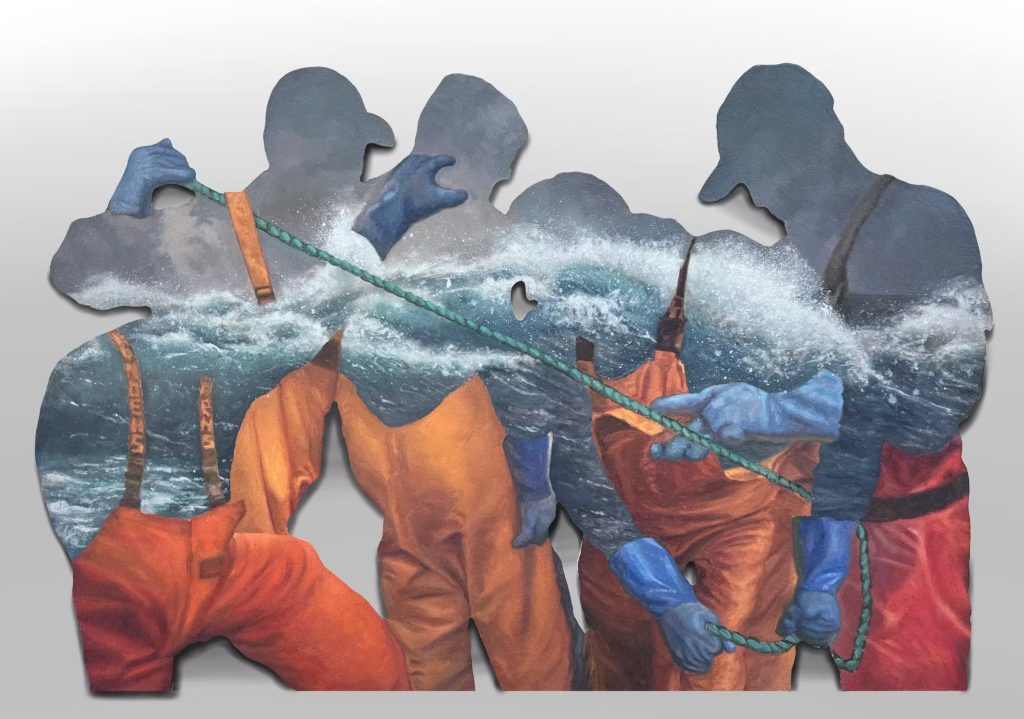In the Northeast, lobstering is a cultural pastime—a generational profession that has been the glue holding small coastal villages together for hundreds of years. Lobstering is more than just a career; it’s a blue-collar lifestyle often carried on by family members. At least that’s the case for Ryan Davis, who, through oil painting, blends first-hand experience with historical references and his imagination to recreate scenes that highlight sailing and fishing practices of yesteryear.
Davis was born and raised in Rockport, Massachusetts, into a family of commercial lobstermen. This tight-knit community, nestled on the craggy coast of Cape Ann, has a rich history of fishing dating back to the 1620s. In fact, the Davis family tree can be traced back some 300 years to the same stretch of shore where he currently resides. His father has been lobstering out of Rockport for 53 years, along with two of his uncles. Today, Davis divides his time between hauling traps 20 miles off the coast in their 50-foot LeBlanc, The Holy Mackerel, and painting from his home studio. Naturally, the life work of his relatives has influenced what he creates on canvas. But Davis, who received his MFA from the New York Academy of Art in 2022, puts a unique spin on traditional New England artwork by combining abstract realism with pop art and graffiti—two styles he grew to appreciate while studying in the Big Apple.
Pop art became mainstream during the 1950s and 60s and, according to Davis, it was used heavily in commercial media like comic books and movie advertisements. It is a style characterized by loud color schemes, basic shapes, and defined lines and edges, which lead to a simple, yet cartoon-like finished product. Andy Warhol is credited for his use of pop art in portraits of Marilyn Monroe, John Wayne, and other prominent media figures during the 1960s. While Davis’s paintings lean into the colorful and playful nature of pop art and graffiti, the subject matter is more serious and natural in appearance. Paintings like Gloucester Harbor Sail and Lost in the Grand Banks take on the elements of graffiti, but feature marine-scapes that are “less animated” than standard street art. It’s clear he draws inspiration from various sources, whether it’s a childhood memory aboard The Holy Mackerel, photo archives from the Cape Ann Museum, or studying the works of local artists including John Terelak, Aldro Hibbard, and T.M. Nicholas.

Davis describes his approach to painting fishing scenes and seascapes as somewhat impressionistic. “I want my work to capture the energy of a scene or subject,” he said, and he relies heavily on color and lighting to do so. His paintings are slightly abstract, which is due in part to the nature of his process. Davis enjoys breathing life into the areas where he grew up fishing and lobstering with his family, but he relies on photos of fishermen, sailors, their poses, and how they relate to the elements—like wind and waves—to elicit the feel he is aiming for.

“The finished product ends up being a collage of images and memories that I’ve meshed together on the canvas,” he added. “I’m telling a story that is visually appealing while showcasing the roots of my community.” Vibrant sunrises, full lobster traps, and white-capped swells lapping the rocky shores reflect the coastal vibe Davis hopes to portray without being overly realistic. There’s an element of dreaminess to his work, and he achieves that abstract aura by placing emphasis not only on color and light, but on texture and the manipulation of shapes.

Currently, Davis’s favorite pieces to work on are his cut-out series. Incorporating shapes that align with the theme of a given painting—like the profiles of gulls, sharks, lighthouses, and porpoises—adds another creative dimension to the canvas, which elevates the energy of the piece and hones the focus of its backstory. Take a glance at paintings like Kicking Up or Hook, Line, and Sink, and there’s no question as to the story being told.

A cocktail of pop art, impressionism, and abstract realism, Davis has developed his own distinct style while paying homage to famed New England artists who have influenced his work, like Emile Gruppé and Winslow Homer. However, one of his greatest inspirations and mentor is Ken Knowles, a fellow local artist and owner of Rockport Gallery. “Ken has been my biggest source of support and inspiration. I had my first solo show, named The Holy Mackerel, in his gallery last April, and he has 20 of my paintings on display now,” Davis said. And it’s not only Rockport locals who have taken a liking to his work. For two years, his paintings have been on display at Gallery Poulsen in Copenhagen, Denmark, which speaks volumes about his ability to connect with an audience beyond Cape Ann and the Northeast U.S.
Davis is full of gratitude for the opportunities he’s had in what is a still-blossoming professional art career, but he hopes to see his work in new galleries as he explores more complex, large-scale projects. “I love the galleries in Rockport and Denmark, but to do this full-time, I’ll have to retire from lobstering in the next year or so,” he admits. He’s even considered returning to New York City, where he first began to expand his creative portfolio, in order to explore new or re-emerging styles.
One thing is for sure, though. Wherever the Rockport native lands, the world is his oyster—or better yet, his lobster.
Instagram: @ryan_davis_artwork

